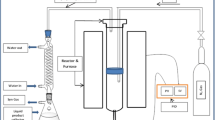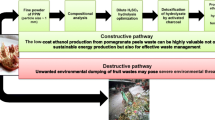Abstract
This study aims to optimize the calorific value with different fuel properties derived from two peat reserved areas. A total of 60 peat samples were evaluated using proximate analysis (moisture content, volatile matter, fixed carbon, and ash content) of two separate studied areas. A quadratic polynomial of response surface methodology was applied to the entire set of subsequently studied results. Several analytical equations were used in linear and nonlinear terms to estimate the higher calorific value. Peat samples at Terokhada Upazila show a higher calorific value of 7.050 kcal kg−1, whereas the calorific value of peat sample at Bil Baghia in Madaripur found 5.800 kcal kg−1. The optimal calorific value of peat in both studied areas is 7.05–11.05 kcal kg−1 in Terokhada Upazila and 3.156–7.187 kcal kg−1 in Bil Baghia, Madaripur, respectively. Terokhada Upazila and Bil Baghia, Madaripur, exhibit analytical values of squares regression of (0.0068–0.1245) and (0.003–0.091), respectively. In addition, the standard deviations are found to be between 1.049 and 4.505 kcal kg−1 for Terokhada Upazila peat and between 0.1741 and 2.741 kcal kg1 for Bil Baghia, Madaripur peat, respectively. The RSM quadratic polynomial represents the optimization, and the coded equations are built for two research areas to precisely estimate the highest calorific value. These peats could be helpful to fuel sources if gasified or co-burned with other fuel resources to generate energy. Peat with a higher calorific value can be used as an energy source in the Bangladesh energy sector and globally.










Similar content being viewed by others
Abbreviations
- RSM:
-
Response surface methodology
- MC:
-
Moisture content
- AC:
-
Ash content
- VM:
-
Volatile matter
- GCV:
-
Gross calorific value
- OLS:
-
Ordinary least squares
- HHV:
-
Higher heating value
- LHV:
-
Lower heating value
- GHV:
-
Gross heating value
- FESEM:
-
Field emission scanning electron microscopy
- SFE-SEM:
-
Schottky emission scanning microscope
- EDX:
-
Energy-dispersive X-ray spectroscopy
References
Ahamed S, Monir MU, Biswas PK, Khan AA (2016) Investigation the risk of spontaneous combustion in Barapukuria Coal Mine, Dinajpur, Bangladesh. Journal of Geoscience and Environment Protection 4(04):74
Ahmed MT, Hasan Y, Islam S, Rahman M (2019) Analysis of fuel properties for peat: a case study. IOSR Journal of Applied Chemistry 12(5):26–43
Buyukada M, Aydogmus E (2018) Utilization of apricot seed in (co-)combustion of lignite coal blends: numeric optimization, empirical modeling and uncertainty estimation. Fuel 216:190–198. https://doi.org/10.1016/j.fuel.2017.12.028
Capuano L (2020) International Energy Outlook 2020. US Energy Information Administration (EIA)
Erol M, Haykiri-Acma H, Küçükbayrak S (2010) Calorific value estimation of biomass from their proximate analyses data. Renewable Energy 35(1):170–173. https://doi.org/10.1016/j.renene.2009.05.008
Gillespie GD, Everard CD, Fagan CC, McDonnell KP (2013) Prediction of quality parameters of biomass pellets from proximate and ultimate analysis. Fuel 111:771–777. https://doi.org/10.1016/j.fuel.2013.05.002
IEA (2020) World Energy Outlook
İlbaş M, Kümük B (2020) Modeling and analysis of a model solid oxide fuel cell running on low calorific value coal gases. Int J Hydrogen Energy 45(5):3577–3583. https://doi.org/10.1016/j.ijhydene.2019.01.286
Imam B (2005) Energy resources of Bangladesh. In D. University grants commission of Bangladesh (Ed.), (Vol. 277.). University grants commission of Bangladesh, Dhaka
Mahmoud M, Ramadan M, Naher S, Pullen K, Baroutaji A, Olabi A-G (2020) Recent advances in district energy systems: a review. Thermal Science and Engineering Progress 20:100678
Mansur FZ, Faizal CKM, Monir MU, Samad NAFA, Atnaw SM, Sulaiman SA (2020) Co-gasification between coal/sawdust and coal/wood pellet: a parametric study using response surface methodology. Int J Hydrogen Energy 45(32):15963–15976. https://doi.org/10.1016/j.ijhydene.2020.04.029
Mansur FZ, Faizal CKM, Monir MU, Samad NAFA, Atnaw SM, Sulaiman SA (2020) Performance studies on co-gasification between coal/sawdust and coal/wood pellet using RSM. IOP Conference Series: Materials Science and Engineering 736:022085. https://doi.org/10.1088/1757-899x/736/2/022085
Mm M, Moniruzzaman M, R. MM. (2011) Management and conservation of organic peat soils for sustainable crop production in Bangladesh. Bulletin of the Institute of Tropical Agriculture, Kyushu University 34(1):93–101
Monir MMU, Hossain HZ (2012) Coal mine accidents in Bangladesh: its causes and remedial measures. International Journal of Economic and Environmental Geology 3:33–40
Monir MU, Abd Aziz A, Kristanti RA, Yousuf A (2018) Co-gasification of empty fruit bunch in a downdraft reactor: a pilot scale approach. Bioresource Technology Reports 1:39–49. https://doi.org/10.1016/j.biteb.2018.02.001
Monir MU, Abd Aziz A, Kristanti RA, Yousuf A (2020) Syngas production from co-gasification of forest residue and charcoal in a pilot scale downdraft reactor. Waste and Biomass Valorization 11(2):635–651. https://doi.org/10.1007/s12649-018-0513-5
Monir MU, Abd Aziz A, Yousuf A, Alam MZ (2020) Hydrogen-rich syngas fermentation for bioethanol production using Sacharomyces cerevisiea. International Journal of Hydrogen Energy: 1-9. https://doi.org/10.1016/j.ijhydene.2019.07.246
Monir MU, Aziz AA, Vo D-V, Khatun F (2020) Enhanced hydrogen generation from empty fruit bunches by charcoal addition into a downdraft gasifier. Chem Eng Technol 43(4):762–769. https://doi.org/10.1002/ceat.201900547
Monir MU, Aziz AA, Khatun F, Yousuf A (2020) Bioethanol production through syngas fermentation in a tar free bioreactor using Clostridium butyricum. Renewable Energy 157:1116–1123. https://doi.org/10.1016/j.renene.2020.05.099
Monir MU, Azrina AA, Kristanti RA, Yousuf A (2018) Gasification of lignocellulosic biomass to produce syngas in a 50 kW downdraft reactor. Biomass Bioenerg 119:335–345. https://doi.org/10.1016/j.biombioe.2018.10.006
Newell RG, Raimi D (2020) Global energy outlook comparison methods: 2020 update: resources for the future
Nhuchhen DR, Abdul Salam P (2012) Estimation of higher heating value of biomass from proximate analysis: a new approach. Fuel 99:55–63. https://doi.org/10.1016/j.fuel.2012.04.015
Olivier JG, Van Aardenne JA, Dentener FJ, Pagliari V, Ganzeveld LN, Peters JA (2005) Recent trends in global greenhouse gas emissions: regional trends 1970–2000 and spatial distributionof key sources in 2000. Environ Sci 2(2–3):81–99
Özyuğuran A, Yaman S (2017) Prediction of calorific value of biomass from proximate analysis. Energy Procedia 107:130–136
Qin L, Wu Y, Hou Z, Jiang E (2020) Influence of biomass components, temperature and pressure on the pyrolysis behavior and biochar properties of pine nut shells. Biores Technol 313:123682. https://doi.org/10.1016/j.biortech.2020.123682
Shahbaz M, Yusup S, Inayat A, Patrick DO, Pratama A (2016) Application of response surface methodology to investigate the effect of different variables on conversion of palm kernel shell in steam gasification using coal bottom ash. Appl Energy 184:1306–1315. https://doi.org/10.1016/j.apenergy.2016.05.045
Simsek S, Uslu S (2020) Investigation of the effects of biodiesel/2-ethylhexyl nitrate (EHN) fuel blends on diesel engine performance and emissions by response surface methodology (RSM). Fuel 275:118005. https://doi.org/10.1016/j.fuel.2020.118005
Singh YD, Mahanta P, Bora U (2017) Comprehensive characterization of lignocellulosic biomass through proximate, ultimate and compositional analysis for bioenergy production. Renewable Energy 103:490–500. https://doi.org/10.1016/j.renene.2016.11.039
Sirisomboon P, Funke A, Posom J (2020) Improvement of proximate data and calorific value assessment of bamboo through near infrared wood chips acquisition. Renewable Energy 147:1921–1931. https://doi.org/10.1016/j.renene.2019.09.128
Tan YH, Abdullah MO, Nolasco-Hipolito C, Ahmad Zauzi NS (2017) Application of RSM and Taguchi methods for optimizing the transesterification of waste cooking oil catalyzed by solid ostrich and chicken-eggshell derived CaO. Renewable Energy 114:437–447. https://doi.org/10.1016/j.renene.2017.07.024
Wang C-H, Ko M-H, Chen W-J (2019) Effects of kyoto protocol on CO2 emissions: a five-country rolling regression analysis. Sustainability 11(3):744
Yin C-Y (2011) Prediction of higher heating values of biomass from proximate and ultimate analyses. Fuel 90(3):1128–1132
Yousuf A, Sultana S, Monir MU, Karim A, Rahmaddulla SRB (2017) Social business models for empowering the biogas technology. Energy Sources Part B 12(2):99–109. https://doi.org/10.1080/15567249.2016.1255677
Zakir Hossain HM, Hasna Hossain Q, Uddin Monir MM, Ahmed MT (2014) Municipal solid waste (MSW) as a source of renewable energy in Bangladesh: Revisited. Renew Sustain Energy Rev 39:35–41. https://doi.org/10.1016/j.rser.2014.07.007
Acknowledgements
We acknowledge our sincere gratitude to the authority of the Institute of Mining, Mineralogy & Metallurgy (IMMM), BCSIR, at Joypurhat, Bangladesh and Energy Conversion Laboratory, Department of Petroleum and Mining Engineering, Jashore University of Science and Technology, Jashore-7408, Bangladesh, for providing us the Laboratory support for analyzing the peat samples.
Author information
Authors and Affiliations
Corresponding authors
Additional information
Publisher's Note
Springer Nature remains neutral with regard to jurisdictional claims in published maps and institutional affiliations.
Rights and permissions
About this article
Cite this article
Monir, M.U., Hasan, M.Y., Ahmed, M.T. et al. Optimization of fuel properties in two different peat reserve areas using surface response methodology and square regression analysis. Biomass Conv. Bioref. 13, 6601–6621 (2023). https://doi.org/10.1007/s13399-021-01656-x
Received:
Revised:
Accepted:
Published:
Issue Date:
DOI: https://doi.org/10.1007/s13399-021-01656-x




